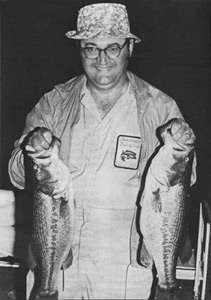
The phone call I received early one evening in 1967 remains etched in my memory. The voice on the other end said, "I'm Ray Scott. Your name was given to me by W.A. Bill Cox Jr. He said you worked with him on a spotted bass article. I'm hoping you'll be able to help me. I recently organized a bass tournament that was held on Beaver Lake in Arkansas. The tournament was a success and I am excited!"Scott continued, "I'm starting a bass club and plan to initiate a magazine for it. I need members and writers. I think the time is right for competitive bass fishing, where winners can claim cash awards like golfers who compete. I'm also hoping to better the bass fishing sport with a unified voice for it."
Ray Scott discussed his ambitions and before hanging up, told me to give it some thought. I'd never heard of Ray Scott and had mixed feelings about his plans, dismissing them as far-fetched. As time passed, I kept hearing more about Scott and the club, which he eventually named Bass Angler's Sportsman's Society, or B.A.S.S.Then Ray Scott sent me a copy of the first issue of BASSMASTER magazine. When I learned that B.A.S.S. was having a seminar at nearby Evansville, Ind., I attended, and afterward talked with Roland Martin, a participant in the seminar. After introducing myself as an outdoor writer, Roland said, "We need more members and writers; think it over." Soon after, I became a member.When B.A.S.S. held a seminar at Louisville, Ky., I attended. It was held in a school gymnasium. There was a lull in the program, and I went down to the floor, hoping to speak to Ray Scott. He immediately remembered me and introduced me to Don Butler, the first member of B.A.S.S., and Bill Dance, one of the club's top tournament fishermen. The two were setting up to show a movie. I told Ray I'd like to talk to him. We went to a hallway nearby. Ray removed his trademark cowboy hat and sat on a metal radiator.First I apologized for not having faith in his plans. He replied, "No apology is needed. Others also thought I had lost my touch with reality." We both laughed at his remark.I asked him where he thought the organization was headed."I don't know," he said. "It's like having a tiger by the tail! I've had sleepless nights wondering if I was making the right decisions."By that time, I had been an outdoor writer for a few years, selling my first article to one of the so-called "big three" outdoor magazines. But Scott inspired me to write for Bassmaster.I proposed two article ideas. Scott liked both, as did the editor, Bob Cobb. The first was published in the September/October 1972 issue, and it was entitled, "Florida Bass California-Style." It was one of the first nationally published articles about California's expanding big-bass potential. Next followed, "Quest For A Super Bass," which appeared in the 1974 Bassmaster Annual. That article received national attention, when a bulletin was widely distributed to the news media about it. Ironically, George Perry, the largemouth record holder, was killed in a plane crash the day the '74 Bassmaster Annual was published.Another article, "The Spotted Bass," featured Bill Cox of Montgomery, Ala., a spotted bass expert who had given my name and address to Ray Scott. The most difficult article was a cover feature for the 1975 Bonus Edition. Titled "Best Bets For Bronzebacks," it was a tremendous challenge compiling this national survey of blue-ribbon smallmouth waters. Artist Ralph J. Mc Donald was commissioned to do the cover art, "Old Bronzeback." He did that one and another cover, "Battling Largemouth," to perfection. Both were made available as fine art, limited-edition collector prints.By this time I was seeing every article I wrote being published. I also held down a full-time job. Then I became regional editor for Outdoors Today, a weekly tabloid. Today, I'm still doing outdoor writing for a variety of publications.Fishing was simple when B.A.S.S. was formed in 1967. But underwent tremendous change thereafter. Bass boats, lures, tackle and related items were soon geared toward the tournament scene.Putting everything in perspective, there's little doubt that Ray Scott's ideas have enhanced fishing beyond his wildest dreams. Conservation efforts he and B.A.S.S. established have benefited the sport tremendously and continue to do so.In most areas, including where I live in southern Indiana, bass fishing is probably better now than in times past. Strip-mine pits I fished in my youth have been re-stripped and the land reclaimed. Other strip-pit waters were sold to private interests who don't allow public access. But, we gained other waters such as Patoka Lake, which is very popular for fishing and recreation.During this time there have been many changes in fishing throughout the nation. Remembering that phone call from Ray Scott, it's almost beyond comprehension how his dreams became reality. B.A.S.S. and BASSMASTER are his legacy, and today he's a bass fishing icon.
